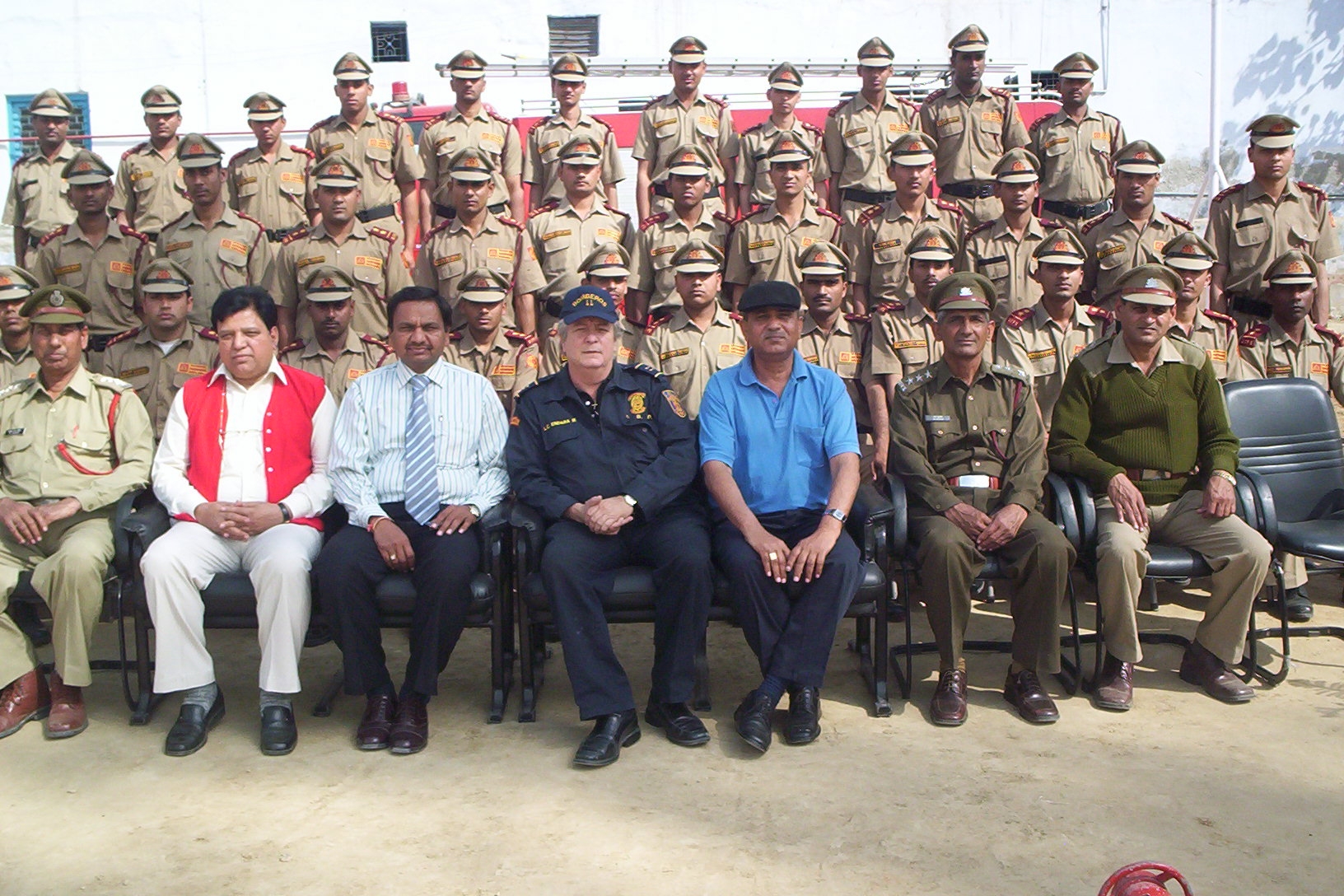


ABOUT THE DIFE
First Aid Fire Protection is all about "Rightly Trained Fire Fighter behind the Right type of Equipment at the Right Time" which can extinguish fire in its incipient stage and prevent it from growing into devastating inferno. The incipient stage is when it’s crucial to fight a fire because it is easiest to suppress it at this point, and it will cause the least damage.
A lackluster approach in this regard would certainly be at our own peril. A fully developed fire is the hardest to suppress because, at this point, the fire is at maximum temperatures and causing the most heat damage. If you’ve failed to suppress it before this point, then your odds of stopping the fire are much smaller.
“The Defence Officer’s Society for Prevention of Fire & Disaster Management”, which came into being in 2003 and is duly registered with Registrar of Cooperative Societies under Societies Registration Act XXI of 1860. It has taken up the challenging mandate of making Society & Industry “Fire Safe” & “Risk Free” by way of spreading awareness in the society and providing its expertise and services to the industry towards Health, Safety & Environment and to generate Job opportunities for youth in the field of Fire Safety and related fields especially in rural India.
In pursuit of the aim and objectives of the Society, Delhi Institute of Fire Engineering(DIFE) raised under control and management of "The Defence Officer’s Society for Prevention of Fire & Disaster Management" to run vocational courses in the sectors of Fire and Industrial Safety including Construction sector.DIFE is one of the premium institute in North India which imparts organized Fire Technology& Industrial Safety Training and is affiliated with the State Council for Vocational Training (SCVT), Department of Training and Technical Education (DTTE), Govt. of NCT of Delhi.
DIFE has dedicated team of well qualified professionals comprising of Defense Services Officers, Fire Scientists / Engineers and Fire Experts who boast of knowing Fire from “Womb to Tomb”. Besides, a panel of Fire Safety Auditors/ Experts of national standing who have credit of having carried out several fire safety audits of PSUs and Pvt. Organizations of national repute form part of our team. In very short span of time, Institute is accredited with ISO-9001-2015, ISO 14001:2015 and ISO 45001:2018 by Magnitude Management Services Pvt. Ltd and ISO/IEC 17020:2012 by BQR Certifications.The DIFE is easily accessible and is located in the vicinity of Asia’s biggest and largest sub city of Dwarka comprising of vast training grounds and high-rise buildings which provide a realistic training infrastructure for the students for carrying out mock Fire Safety/Rescue drills.
Introduction to New Fire Fighting Technology
The erstwhileeducation system involved instructor-centered traditional education, which included all the requirements of traditional teaching and learning such as crowded classrooms, instant information sharing, impersonal approach to students, materials like black/white boards, desks, and pencils. Education discipline mainly concerned with methods of teaching and learning in schools or school-like environments . Conventional approach refers to the traditional way of teaching wherein most of the time lecture method is used. This method of teaching is textbook centered, teacher dominant, exam-oriented. The emphasis here is mainly in remembering and reproducing facts, principles and theories of learning. Besides others, Education helps you develop critical skills like decision-making, mental agility, problem-solving, and logical thinking. People face problems in their professional as well as personal lives. In such situations, their ability to make rational and informed decisions comes from how educated and self-aware they are. The major role of education is also to help a person in getting proper employment in the area of his interest and become financially independent and serve the society in general with his educational qualification and experience achieved during his job. The conventional methods of enquiring education have become redundant and obsolete which are of very little importance in the modern time of technological and scientific progress.
The world has made tremendous technological / scientific progress in past two decades and has placed human being at such a height of the progress which is unparalleled in the recent history of human being. This technological and scientific progress has opened lots many branches / disciplines and faculties in the field of technical education and one of them is fire engineering and technology which has emerged as a very important branch of technical education. Hitherto, fire engineering education was an ignored field in our country and very few people used to adopt fire engineering as a career. But recent technological and scientific advancement has forced the human being to be more serious and aware to preserve and safe guard its inventions in the field of technological / scientific progress.
Industrial fires pose hazards to the facility, personnel and surrounding communities. The release of a flammable material can produce a fireball, pool fire, flash fire, flare or jet fire, and even an unconfined vapor cloud explosion.The risks of explosion, chemical releases and rapidly expanding fires are great in industrial facilities. The Industrial fires every year account for massive losses of lives and property.But technology is making its mark on industrial fire operations and will continue to do so in coming future as innovative gismos and gadgets enter the fray to help fire brigades prevent and douse fires. Here are technology breakthroughs set to make a permanent impact in industrial firefighting in near future.
Advances in Drone Technology
“Drones give you a complete picture of the scene while keeping humans out of harm’s way.” Using drones for industrial fires, where firefighters may encounter wickedly hot blazes, explosion risks, toxic fumes and hazardous chemicals, is increasing.Drones deliver aerial imagery that enhances situational awareness. New low-cost, thermal imagery solutions on drones improve visibility in difficult conditions. The technology helps drones “see” through smoke to deliver key information to firefighters. Incident commanders can receive real-time video, overlaid area topography and maps to gain insight that enhances the firefighting mission. When drones fly overhead, the technology can pinpoint hidden fire in roofs and walls to better protect firefighters. Should humans remain in the building, this technology also can pin down their whereabouts.
Taking on Thermal Imagers
“Just as every firefighter has a flashlight and a radio, every firefighter will soon have a thermal imaging camera.” Personal thermal imagers will change how brigades fight industrial fires. Their uses include:
- Primary Searches : To scan for people and pets and locate the source of the fire.
- Self-Rescue : An additional lifeline to help firefighters find their way out of low visibility. They can locate windows, cooler regions, and hose lines for self-rescue.
- Downed Firefighter Situations : Firefighters can respond to mayday calls and locate fellow members in smoke-filled environments.
- Alarms, Smells, and Smoke: Teams can identify the source of hidden problems. The unit can help identify hotspots, faulty wiring, shorts, and more.
- Hazmat: Hazmat teams can investigate and identify hazardous material levels in tanks and pressure vessels and investigate situations from a safe distance.
- Overhaul: Using thermal imagers increases the number of eyes searching for hot spots so teams can leave the scene confident that the fire is out.
- Non-Fire Search and Rescue: Help find missing people in the dark.
- Training: Teach firefighters about fire dynamics.
- Situational Awareness: The tool helps firefighters keep visual contact with other members in low visibility situations to improve situational awareness and efficiency.
Connected Firefighting
The internet of things (IOT) has ushered in useful features for business and personal use. Now the IOT promises to wirelessly connect firefighting tools to enhance safety and staff.IOT can be relied upon to engineer an all-in-one safety solution ecosystem of products to help firefighters view a situation in real-time while staying connected to each other. The connected firefighter platform comprises:
- LUNAR : A handheld search-and-rescue device using thermal imaging technology to identify edges, people, doors, windows and other venting sources. It also includes a motion detector that sounds an alarm and broadcasts a distress signal to nearby personnel if a firefighter becomes incapacitated.
- FireGrid : An integrated system that connects all LUNAR devices as soon as they turn on to provide real-time accountability of firefighters’ status and location, whether or not they wear breathing apparatus. It feeds the collected data to on-scene commanders and remote personnel, such as a dispatch center or fire station.
- MSA Hub :A device creating a wireless gateway using its own hotspot by tapping into cellular technology. If cell signals are unavailable or severed, it creates its own cloud-based hotspot to communicate with all devices within range.
Previously, data about individual firefighters only became available when they connected to a SCBA that relayed their estimated air pressure, battery life and time remaining. In contrast, LUNAR uses advanced technology to relay that information and other data to assist a firefighter carrying the handheld device.
Even when not connected to SCBA, LUNAR detects a downed firefighter and broadcasts distance and directional information to other personnel who can use the device’s thermal imaging feature to rescue that person in restricted visibility.
Equipped with firefighting assisting search technology (FAST), LUNAR constantly broadcasts real-time information about a firefighter’s location and status. For example, if a firefighter has not moved in 30 seconds, LUNAR’s motion detection sensor recognizes a problem, broadcasts a distress signal and emits an audible alarm.
Innovations in PPE
Many firefighters die in the line of duty during fire emergency. Though the reasons for death vary, the No. 1 cause remains consistent year over year. Overexertion, stress, and medical issues contribute to most firefighter deaths.
Other factors leading to death include the hazards of the job: heat and smoke inhalation, explosions, falling objects, structural collapse, falls and electrocution.
Smart personal protective equipment (PPE) aims to reduce firefighter deaths by sending critical lifesaving information to incident commanders.
Companies pattern smart PPE after smart phones, smart watches and Fit Bit-style devices, which already deliver powerful insights about health and performance. These devices typically include a myriad of Internet of Things (IoT) sensor technology, such as gyroscopes, GPS, accelerometers, barometric pressure readers, and heart rate monitors. Each provides valuable insights about the user.
- Gyroscope data can share when the wearer falls or hits the floor, prompting an inquiry into their condition.
- GPS accurately shows the user’s location. If used in smart PPE, commanders could see where firefighters are to direct backup or emergency assistance.
- Accelerometersprovide clues about the wearer’s speed. Should it change rapidly, commanders can investigate why.
- Barometersprovide information about the wearer’s altitude. If used in PPE, commanders can tell whether a firefighter is on the first or third floor. They will know where to direct backup or whom to call out.
- Heart rate sensorsindicate fatigue, overheating and overexertion.
The challenge has been making sensor technology available to wearers in a heated environment filled with smoke and toxic fumes. The average Fit Bit, smart phone or smart watch cannot withstand the conditions firefighters face on the job. IoT advances surmount these challenges. It is now possible to create rugged sensors for smart PPE that share pertinent data with incident commanders over the cloud.Smart PPE improves situational awareness as it collects data, sends notifications, and adjusts to internal and external conditions. It benefits frontline personnel by tracking their location and health condition and dispatching the data to authorized officials.
Sustainable Trucks
Fire departments around the world are seeking quieter, cleaner and greener vehicles. Now electric fire trucks are available to meet these needs.They will provide the environmental benefits fire departments request, without having to compromise on operational performance, functionality, safety attributes, customization, and the traditional configurations or styling customers expect from the fire apparatus.”The design allows zero-emissions operation when powered by the integrated onboard batteries. The truck also couples to an internal combustion engine to provide uninterrupted power to the pumping system or drive system. Electric Vehicles are the future of Fire Services. Many international Fire Fighting Organizations have goals to establish green fleets within the next decade or so.
Turnout Gear Advances
Turnout gear presents manufacturers with an interesting conundrum. The protective clothing’s main job is to shield firefighters from the very fire they’re fighting. But this gear also must protect in a way that “prevents the No. 1 killer of firefighters, which is heat stress, while safeguarding them from the No. 1 disease, which is cancer,”.It’s a scenario without easy answers. Most turnout gear worn by firefighters contains per- and polyfluoroalkyl substances (PFAS)—a toxic class of chemicals used to meet water-resistant uniform standards. But studies link PFAS chemicals to a variety of health problems, including cancer, even at low doses.
The latest turnout gear innovations are changing the tide. PFAS-free materials, such as fibers from DuPont, do not use short- or long-chain PFAS in the aramid spinning process. Honeywell’s Morning Pride division now offers PFAS-free turnout gear. And Fire-Dex, a family-owned global PPE manufacturer, has announced TECGEN71+ and TECGEN51+ PPE fabrics with a PFAS-free water-repellent finish.PFAS-free fabric comes with minor tradeoffs. The fabric loses some water and oil repellency, meaning it absorbs slightly more of both than its PFAS-containing counterparts. But PFAS-free fabrics still meet NFPA 1971 standards.PFAS-free gear offers the same thermal protection and moves the same way. The color fastness and wear remain the same.
Anything we can do to reduce heat stress at a fire event and help firefighters cool down faster as they exit the fire is incredibly important.We push our suppliers to see how lightweight they can get while keeping durability and protection high.
The six technologies listed above are changing the way we fight fires today as researchers and developers innovate and increase their sophistication for tomorrow.










